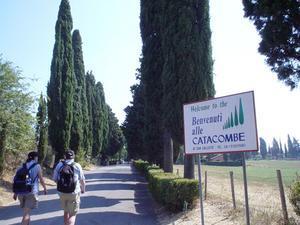Advertisement
Published: November 5th 2005

 Benvenuti alle Catacombe di San Callisto
Benvenuti alle Catacombe di San Callisto
Welcome to the Catacombs of St Callixtus.Rome is a good place to learn about history of Christianity, and catacombs are an important part of the learning experience. Unfortunately, there are only few people would consider the opportunity to check out catacombs when visiting Rome, and as our time in Rome is running short, I decided to visit a catacomb.
Catacomb is always an intriguing place for me, especially with my goal of becoming a better Christian. Many early Christians lived in catacombs as places for sanctuary from Roman prosecution, where they died, buried, and hoped to resurrect with Christ at the end. Other than fulfilling my goal, Roman experience is not complete without visiting a catacomb; besides, who doesn’t want to experience a real eerie place, dark and mysterious, except the fact that I don’t think any of these souls would haunt anyone alive? Aren’t they all saints and holy people? (Duh! I can be so naïf sometimes).
“
How to get there” becomes a real challenge, as no direct Metro would take us there directly. The trick is that one needs to go to San Giovanni Metro stop, and goes directly to any number 218 blue bus that make a stop in front of the
Basilica. This bus would go to via Appia Antica, where several different catacomb entries are located. There are many signs showing directions to several different catacombs, but we wanted to go to Catacombe S. Callisto, supposedly the biggest and the most famous one that opens for public. To my surprise, most of the people on the bus appeared to be tourists, and all of us were going to catacombs.
There were several tours in some languages offered, and of course by any means, we chose the English tour. Our tour guide was Father Richard, a priest from UK that told us as the introduction that the S. Callisto catacomb contains more than half million human remains in its 12.5 miles maze that is dangerous for anyone who is wondering around and not familiar with the place. It was rediscovered in the 1800s, and only two out of four levels of the catacombs have been excavated; there are still many bones and remains all around us, literally.
There were rows and rows of empty niches and holes that are stacked up floor to ceiling at both sides of the main hallway we walked by; unfortunately, visitors have stolen bones
and remains overtime. Yeah, right, who doesn’t want to carry a leg bone or a ribcage around? People could be so stupid sometimes. After experiencing many grave digger that wouldn’t hesitate to open up a sealed tomb to seek some valuables, bones were removed to be stored somewhere else. Remind you that there were only about half of this catacomb explored so far, the other half is still intact.
One thing I noticed almost immediately was how shorts these people were; the empty holes and notches we saw were roughly about five feet in length; and obviously these people were shorter than that. Later on, Father Richard mentioned that the average people height back in Roman period was around 4’-7”, which would make my 5’-11” figure as a giant. And all this times I thought I was short.
The highlight of the catacomb was the Tombs of the Popes, where eight popes were buried. During Roman prosecution in the 3rd century, Pope Sixtus II celebrated a mass in the room where Roman soldiers stormed in and decapitated the pope and four deacons in front of the congregation in hoping of discouraging Christianity belief, but unfortunately for Romans, the

 Catacombs
Catacombs
We are not supposed to take any pictures.plan didn’t work as the people were still continued on with their belief.
St. Cecilia, the patron of song and minister, was prosecuted by the Romans and were buried here in this catacomb. Her remains were still intact when the tomb was opened hundred years later; and her relic was removed to Santa Cecilia in Trastevere. In her tomb, a marble statue was placed to show us the important sign she left us all; one hand shows three fingers that signifies the Father, the Son and the Holy Sprit, and the other hand shows one finger that signifies the unity of the three.
There were also several other important tombs and sites, including St. Tarsicius tomb and many smaller chapels that contains frescoes and one of the earliest Christian paintings that includes lots of Christian iconic and biblical symbols. As a closure, there were two sarcophagi contain thousand year old human remains that was hard to recognize due to their age.
Advertisement
Tot: 0.057s; Tpl: 0.01s; cc: 9; qc: 26; dbt: 0.0306s; 1; m:domysql w:travelblog (10.17.0.13); sld: 1;
; mem: 1.1mb









tessa clarke
non-member comment
Thank you for your intellegent comments on the various sites visited. I hope to visit Naples soon and I wanted a sensible view of the place. So many horror stories about the crime in Naples.